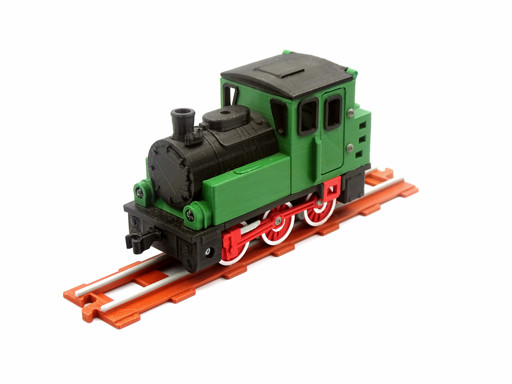Small steam locomotive - Assembly manual
Needed parts or materials (suggested, you can use other matches parts)
- 32 pieces M2.2x6.5 screw (DIN7981),
- several short pieces of filament 1.75 mm for hinges,
- cyanoacrylate glue (not essential but may be needed to glue the wheels to the axles).
Optional parts
- the locomotive is prepared for assembly of a set of lights (4*white LED 5 mm), you can also use white LEDs as an imitation of reflectors (even if you do not intend to connect them to the battery),
- to the project was added an additional boiler element, adapted for mounting two PCB 7*7 mm switch ON/OFF.
3D printing
- We recommend using PLA filament, nozzle 0.4 mm and layer height 0.2 mm, but you can test other settings.
- All files are in print-ready positions, you don't have to rotate it on your slicer.
- The elements are easy to print and do not require the use of supports, brims or rafts (the only exception is the wheel axles, they should be printed vertically. We recommend using a small brim).
- Print all elements with 100% filling (the locomotive runs better if it is a little heavier, the differences in time and filament consumption when printing with a small filling are not significant).
Assembling of parts
- If you don't want to use LEDs, you can use lamp-instead-of-LEDs.stl file instead.
- The sizes of the wheels and axles should match, but if they are too loose, try to stick them with glue. You can also slightly chamfer the ends of the axle with a regular sharpener.
If the axle is too thick, you can gently sand the hole in the wheel or you can very gently change the scale of the axle.stl file when cutting in a slicer (change the scale of the element only for horizontal, the vertical scale should remain at 1:1). We have designed a special wheel and axle assembly tool, you can print it and use it to make your work easier.
- Make sure the opposite wheels are turned 90 degrees (there is a small marker on the axles to help you with this). This is very important because if the angle on any of the axles is different, the wheels will jam.
- Try not to tighten the coupling rods coupling-rod.stl. They should be free and easy to spin. If the coupling rods are too tight, you can slightly enlarge the holes in them.
- Before assembly, be sure to check that the crosshead.stl crossheads move freely and without jamming along their guides crosshead-guide.stl. Getting the coupling rods to move freely may require some effort, but does not require complicated actions.
- Before assembling the cabin, check that the brake lever turns freely.
- Use pieces of filament 1.75 mm to attach doors and roof.
Maintenance
The axles of locomotives and wagons are plastic, so after long-term use, the vehicles may experience greater resistance and may creak while driving. To extend the time of trouble-free operation, we recommend lightly lubricating the axle with Teflon grease.
Compatibility with older versions
-
On July 30, 2025, file names were changed because of a new unified file catalog. Archives, videos, and instructions were also updated. The models stayed the same — only the file names changed.
If you use older archives, please watch the previous instruction video.
-
On June 26, 2022, the way couplers are mounted was changed to make trains work better on tracks. If you downloaded models before this date, you can print and install the new version of TAQ01-coupler-auto.stl and TAQ01C-coupler-cotter.stl in older wagons (included in the free locomotive model). You can also flip all couplers upside down in older wagons, but this is not recommended — trains will not take curves well on the tracks.
Assembly manual movie
Click to see assembly manual on Youtube.
Turn on subtitles (if available) to see part names. Do not use YouTube auto translate.
You can pause the movie and skip frames using "<" and ">" buttons from your keyboard.

